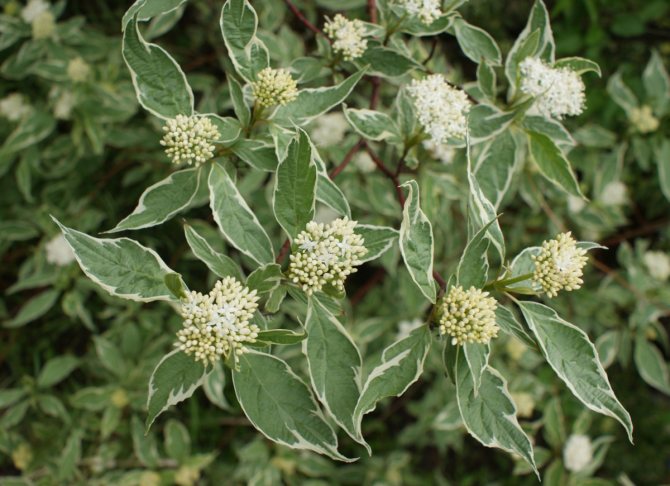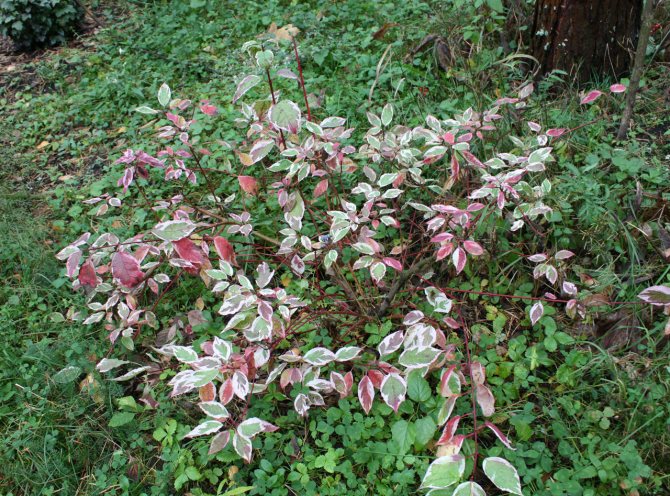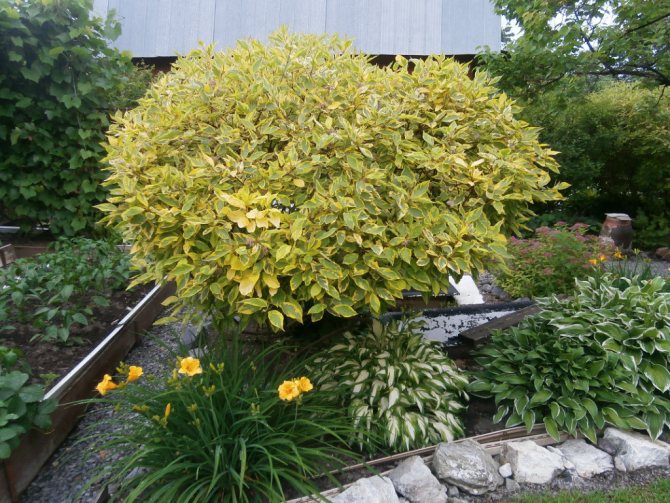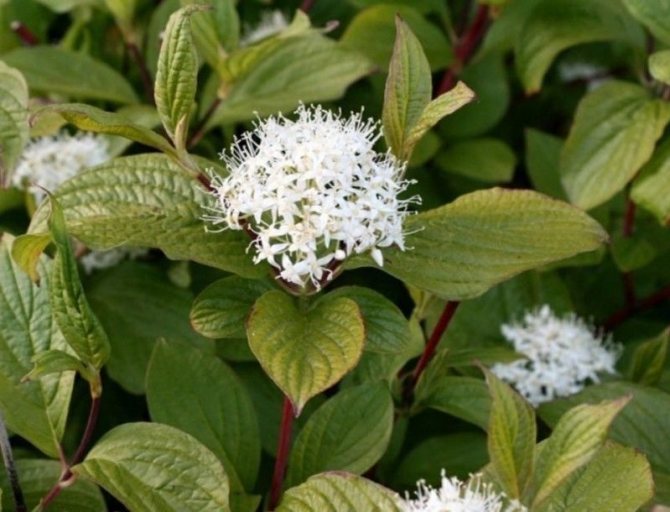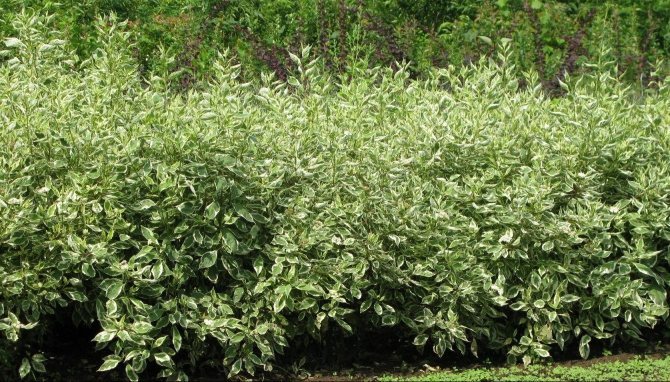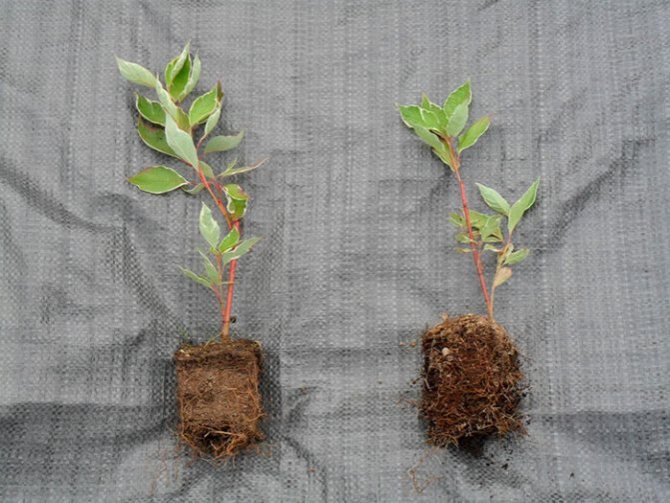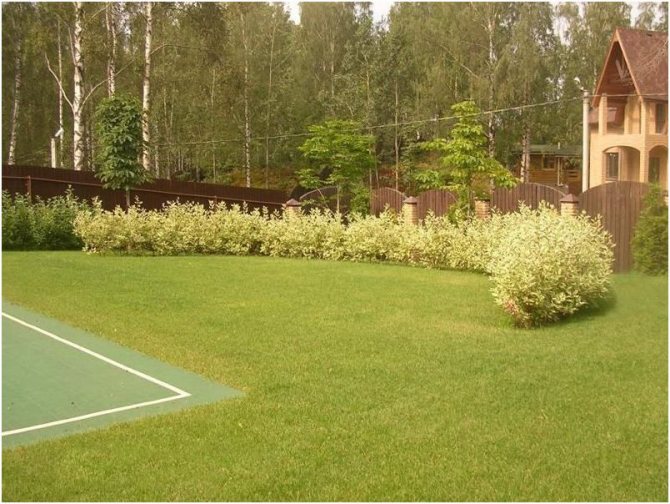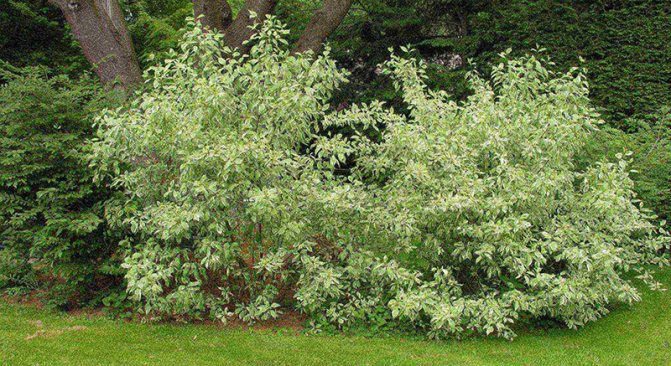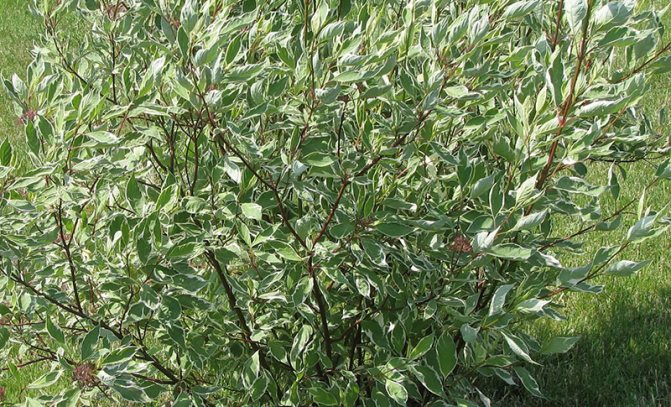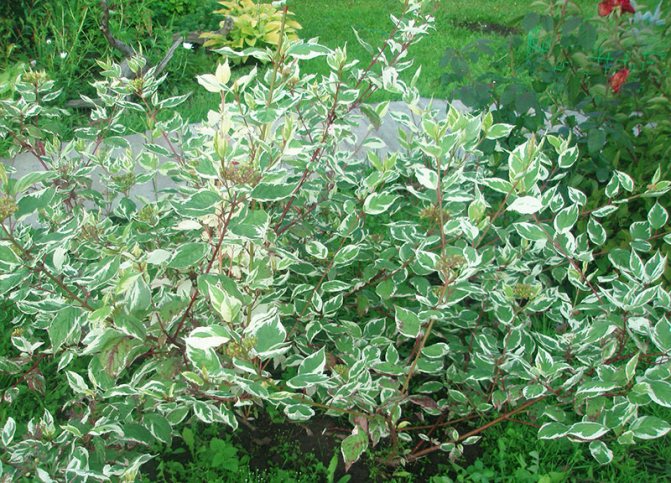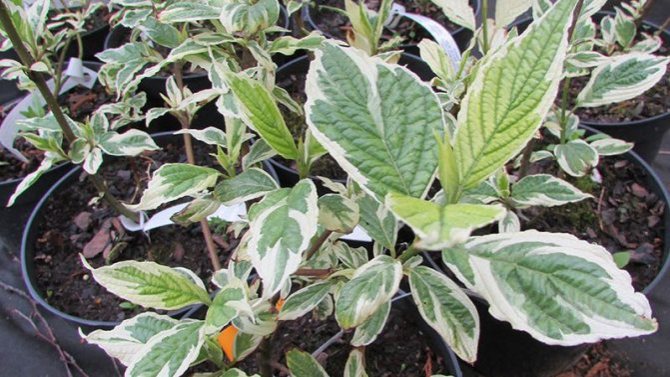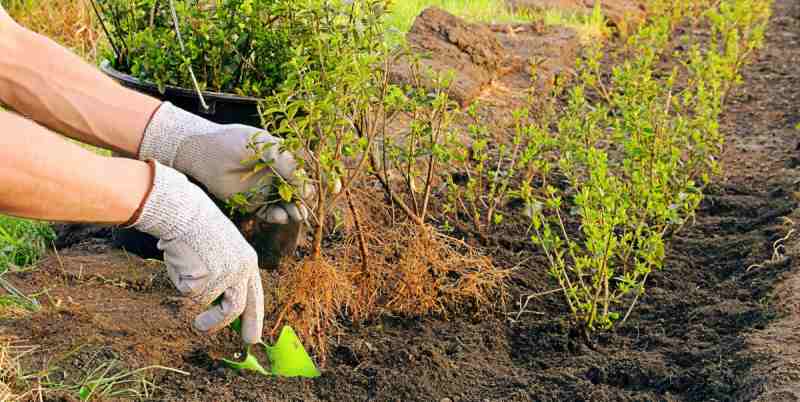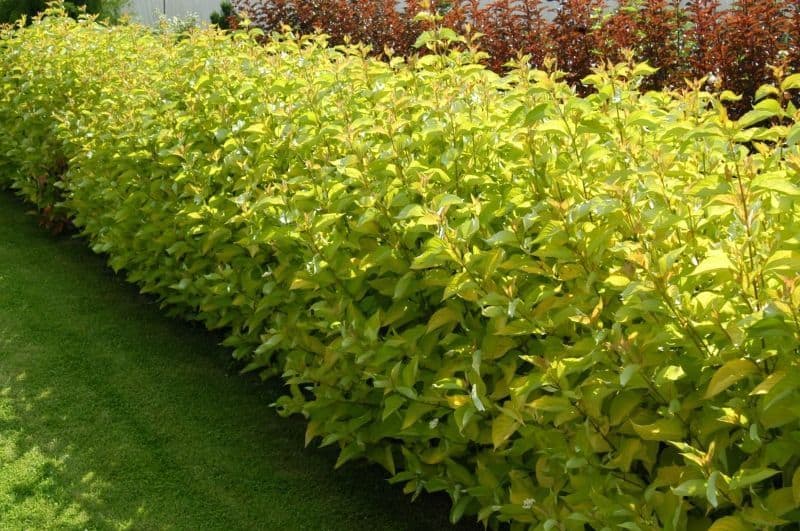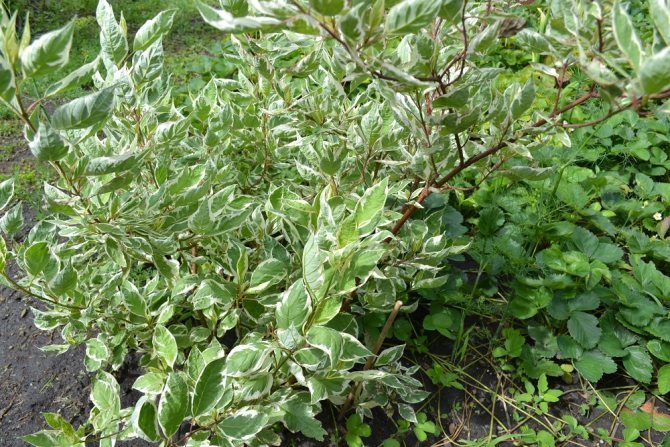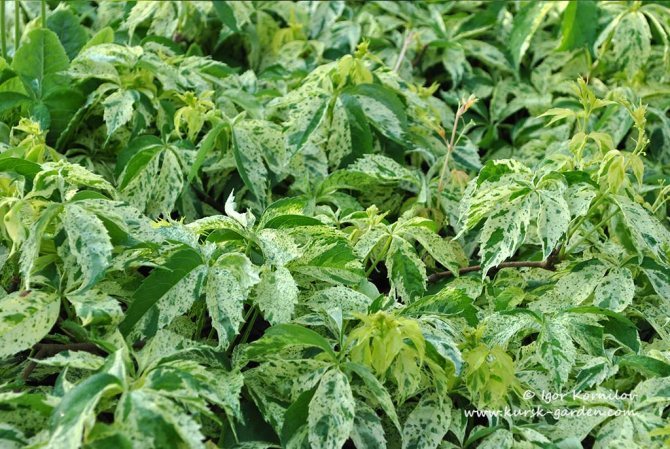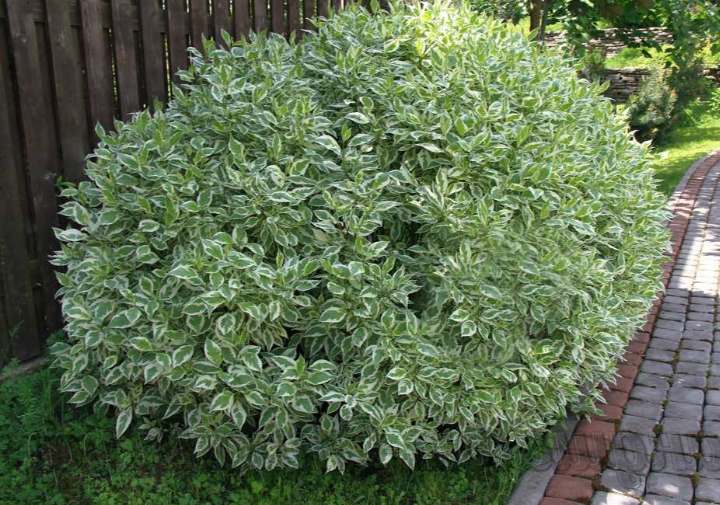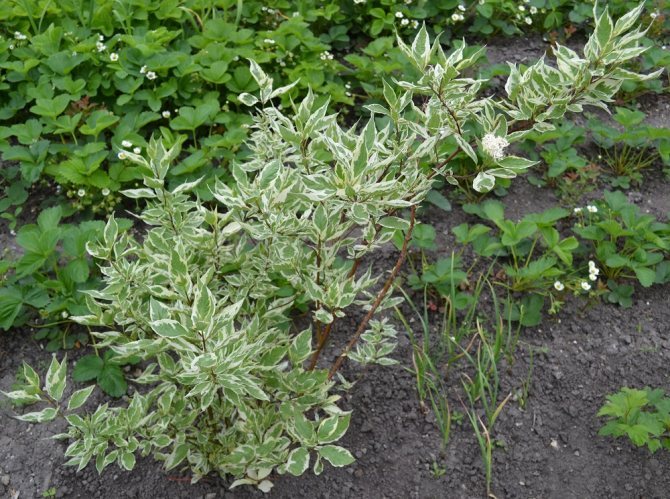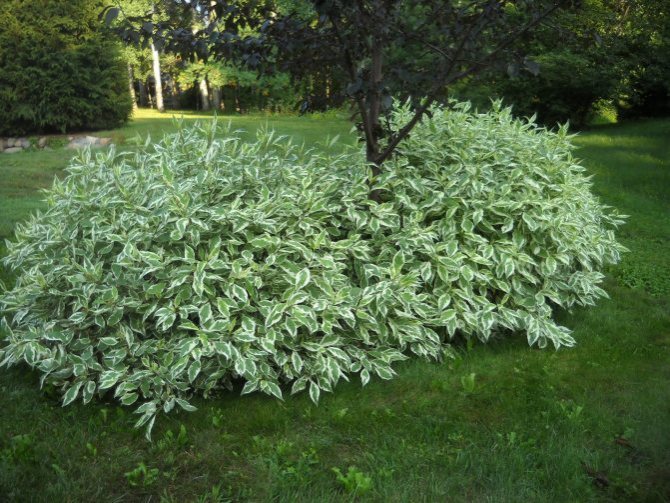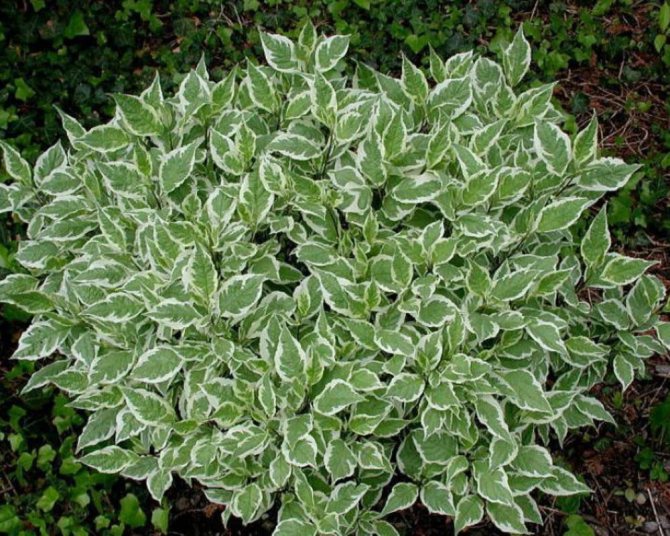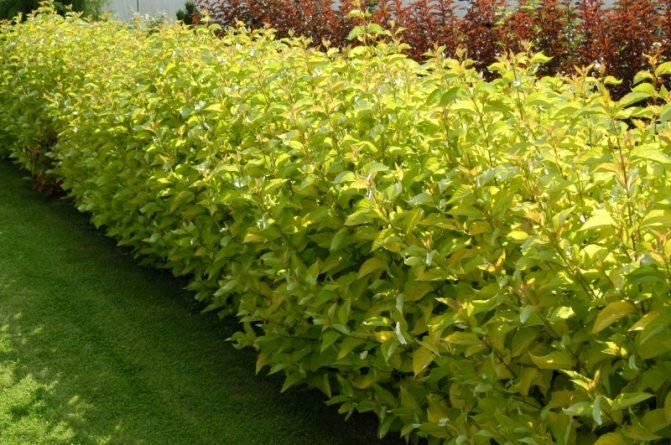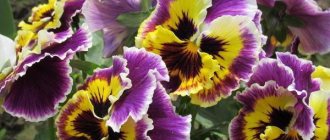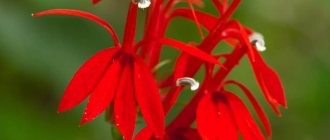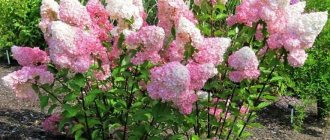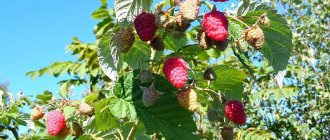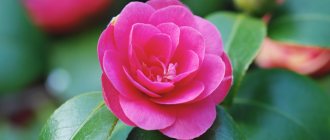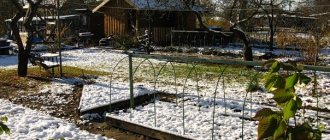Variegated Derain is an ideal perennial plant for planting in dusty or gas-polluted areas. This bush is not only unpretentious in terms of soil, air and light, but also has a high level of decorativeness, and is also not afraid of cutting and absolutely calmly tolerates severe frosts.
This whole bouquet of useful properties alone made this plant one of the most popular and loved in landscape design.
There are several types of this plant, it can grow both as a shrub and as a tree.
The flowering period of the shrub begins in June, during this period, in addition to the decorative foliage, small white flowers gathered in bunches begin to bloom on the plant. With all this, the shrub does not stand out much against the background of other plants.
In mid-September, the derain begins to show itself in all its glory. Leaves will begin to acquire an unprecedented variety of colors and shades, from yellow to deep purple. During the summer, berries will grow on the plant, which in the fall will also transform and change their color.
In winter, variegated dogwood will also delight the eye, standing out from the general picture of grayness against the background of other plants because the branches of the bush are colored orange and red. It looks amazing against a white background.

Some types of shrubs begin to bloom in early spring, standing out against the general background of a garden that has not yet woken up.
Thus, this amazing plant can decorate your site all year round.
In landscape design, a huge number of various subspecies of deren are used, which include eternally green plants, but most often, white deren is used in decorating gardens, park alleys or just a summer cottage.
Shrub description
This shrub is shaped like a ballreaching a height and width of at least 3 meters. Takes pruning very easily, but some gardeners, on the contrary, like their hanging branches. The color combination of branches and foliage gives this plant an attractive look when decorating a garden plot. Depending on the type of this shrub, the leaves are green with different edging.
It begins to bloom in late spring or early summer. White flowers, collected in inflorescences, reach up to 5 centimeters in diameter. In autumn, after the end of flowering, inedible berries appear on the variegated dogwood. Since this plant is frost-hardy, it is used in the north in the design of garden plots.
How to propagate Doren
Propagation of Doren is most convenient by cuttings or layering. Seed propagation is also possible, but it will take several years of waiting to get the result.
Propagation by cuttings
The easiest and most convenient way is grafting.
Cuttings are cut at the end of July. At this time, the shoots become semi-lignified, but when bent, they still do not break. The stalk is cut with a sharp knife or pruner at an angle of 45 degrees. For successful rooting, most of the leaves from the cutting must be removed, leaving a few small leaves.
For rooting, the cutting is immersed in clean river sand or in a mixture of sand and peat. It is recommended to process the base of the cutting in a root formation stimulator.The prepared stalk is buried in the sand at an angle of 45 degrees by 2-3 cm, watered and covered with a bag or jar. This is necessary to maintain high humidity.
If everything went well, then in 1.5-2 months new young leaves will appear on the handle.
Reproduction of Derain by layering
It is convenient to propagate dogwood and layering. This is done in the same way as with the method of propagation by layering of currants or other shrubs. To do this, you need to choose the most suitable shoot, pin it to the ground and sprinkle it with soil. After rooting, cut off the mother branch and transplant to a previously prepared place.
Known shrub species
- Dogwood white... A fluffy shrub with beautiful variegated leaves with a white border. If you look at it from afar, the plant will appear completely white. Perfectly transfers the shadow side. In autumn it becomes reddish-purple.
- Doren Coase... It has dark green foliage at the top, passing downward with a bluish tint. During flowering, beautiful green-yellow flowers appear on the bushes. In autumn, the shrub becomes bright yellow. Edible berries appear after flowering.
- Dogwood red... A very tall shrub, sometimes reaching a height of 4 meters. The leaves of the plant are rounded, bright green in color. In autumn, the leaves turn red, hence the name. During flowering, small white flowers appear. After flowering, small black berries appear on the bushes.
The most popular varieties and types of variegated deer
- – Elegantissima - the most common subspecies of variegated deer in gardens and summer cottages. This type of shrub is great for single plantings and forming, for example, a ball shape. The leaves of the elegantissim tree are bluish-green and have a thin white border. The elegantissima blooms with old or pale pink flowers.
- – Siberia and Sibirica variegata - a feature of these subspecies of variegated turf is that they are short bushes (about one and a half meters in height), and they are also very dense. The leaves are long green, in Siberian variegat, the leaves are bordered with a snow-white strip. In autumn, the foliage becomes almost purple, which also looks very bright and beautiful. Siberia and Siberia variegated bloom with pale green inflorescences, decorative berries are blue.
- – Aurea - a variety for those who love autumn shades, because all summer this shrub pleases gardeners with the yellow color of the leaves, which again looks very impressive in combination with the red stems of the shrub.
Planting variegated turf
Any landing begins with choosing a place on your site, taking into account landscape design. Since variegated dogwood grows well both on the sunny side and in the shade, this simplifies the choice of a planting site. Taking into account the fact that the shrub will grow over time, you should not plant it next to tall trees and other shrubs. The soil, preferably, should be loose sandy, not clayey.
After waiting for the ground to warm up enough in spring, you can start planting a young plant. This will help the dog to adapt to the new location more quickly. There are some secrets to keep in mind when landing.
- Add compost or humus to the prepared pit. You can also add mineral fertilizers.
- If the soil is too wet, drainage is necessary.
- The seedling must be chosen up to 4 years old.
- If the seedling has dry roots, it must be placed in a bucket of water for a while.
When all the nuances are taken into account, you can start planting. It is not necessary to lower the seedling too deep, only so that the earth covers the root system. The planted bush must be watered abundantly and loosen up the earth. Then, sprinkle with mulch around the bush.
Common varieties
The variegated turf shrub has several varieties that differ from each other in appearance. These varieties include:
- Elegantissima. The bush has concave leaves on the branches, gray-gray, there is a white edging along the edges. Thanks to this edging, the variety is often called white-edged sod.
- Sibirica Variegata. Variegata is popular for its bright red branches and flat green leaves, which are also surrounded by a white border.
- Gouchaultii. The variety is a massive shrub with variegated leaves, with a wide yellow edging along the edges. Under the sun's rays, the yellow-leaved turf takes on a pinkish tint.
- Cream Cracker. An incredibly beautiful variety of deren can be distinguished by its leaves, which have a cream-colored edging. The crown is dense, located vertically upward.
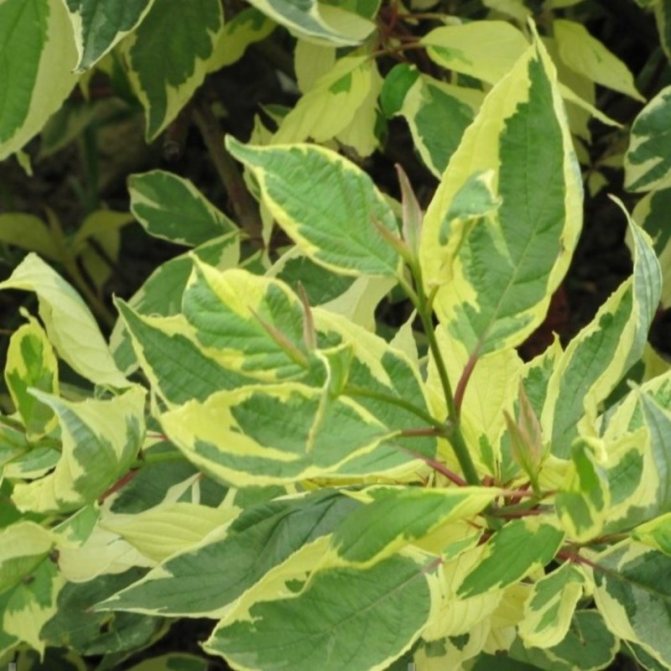

In addition to these varieties, there are also undersized and compact ones, the maximum height of which reaches 1.5 m.
Shrub breeding species
Seed propagation gives good results. For planting, seeds are taken from plants at least 3 years old. The seeds are planted in the ground in the spring, but they can be planted in the winter as well. For this, a mixture of sand, sawdust and moss is prepared. Seeds are planted in an amount of 5 to 15 per square meter. This method is rarely used by gardeners, as it is very long. The bushes reach their normal size only after a few years.
It is much faster to propagate by cuttings... In the spring, when pruning bushes, propagation material is selected. Cut cuttings should have 7-9 buds. Saplings from cuttings are prepared all season, and in autumn they are planted in the ground according to landscape design.
Most often, gardeners use layering propagation. This is a very simple and cost effective method. It is usually held in the spring. Small grooves should be made next to the selected bushes. Long stems descending from the bush, put in these grooves and fix with something... Cover the stem with earth and water abundantly... During the season, the cuttings will take root and can be transplanted next spring.
Another breeding method is dividing the bush. In the spring, a part of the root system with shoots is separated from the dug out bush. Then young specimens are planted on the site without disturbing the landscape design.
Dogwood in garden design
If you plan to use Doeren as a hedge, then the bushes are planted at a distance of 30 cm from each other. And in this case, pruning is necessary at least 2 times per season - in spring and in August. Also for these purposes, viburnum bladderwort is also suitable.
It is not recommended to plant nearby plants with different leaf colors. Variegated varieties are planted separately from plants with green leaves, since the latter will shade variegated leaves, which, as a result, change their color.
There are varieties of Derain variegated with golden leaves, which gives a special beauty to the plant. Usually, deciduous dogwood is grown in central Russia. But even bare branches do not spoil the plant in autumn and even in winter. Deuren's shoots have a very original color: yellow or red, and they look very impressive among the snow-covered area.


Derain bushes care
In general, this plant is considered unpretentious and all care will consist in regular watering, pruning and feeding. Young bushes should be watered daily with a little water. Older bushes are watered only in dry season 2 times a week. Two buckets of water will be enough for each bush. Shrub care includes loosening the soil around the plants. It should always be carried out after watering and rain, allowing oxygen to flow to the plant's root system.
Pruning is an essential part of caring for your bushes. During pruning, the bushes can be shaped to fit into the landscape design. At the same time, dried and diseased stems.In order for the shrub to develop better, it must be fed. You can feed with solutions of manure and chicken droppings. In the spring, be sure to add mineral fertilizers to the top dressing.
Dogwood white: planting and care in the open field, photo
White svidina is described a little higher, this highly decorative and resistant plant obeys all the rules of planting and care, which have already been described. The most important part of the care is pruning, once every 2-3 years, completely remove the shoots to stimulate decorative, lush flowering. Then the culture will decorate your garden with bright colors for a long time.
On a note! Do not worry, the bush will quickly recover after such a dramatic haircut.
Features of planting white turf in the suburbs
As in the case of variegated brethren, the white svidina will need shelter for the winter in the Moscow region. Some gardeners prefer to form compact plants and plant them in large flowerpots, and bring them into the basement for the winter.
Disease and pest control
Dogwood variegated is very resistant to diseases. With proper care, it can grow in one place for years without getting sick. But nevertheless, if the plant is damaged by a fungal disease, it is necessary to cut off the diseased branches, and treat the bush with a solution of "Fundazol". Young bushes can also get sick with svidine gall midge. It can be determined by the swelling on the stems. These stems must be cut and burned.
Among the insects that can harm the plant are aphids. It mainly affects young bushes.... If aphids appear, then all turf plantings must be treated with "Decis" so that the pest does not spread. Spider mites may appear during the dry season. During this period, the bushes should be sprayed with water, and the affected plants should be treated with a solution of any insecticide.
Dogwood variegated
Transplant rules
If an adult bush is transplanted to a new place, then it will be a great stress for him. That is why the transplant is performed only in cases of emergency. The main reasons for this procedure are:
- Incorrect landing site.
- Wrong soil selection.
- Unsuccessful neighborhood with other horticultural crops.
It is recommended to replant adult specimens in late autumn, when the shrub has already shed its leaves. Thus, the transplanting will become less stressful for the plant, since the turf will have more time to acclimate.
If the transplant must be carried out in the spring, then it is recommended to do this until the buds on the branches have swollen.
Plants are transplanted together with an earthen clod, very carefully, without damaging the root system. The border of the root system can be determined by the outline of the crown. She digs in a circle of bushes, very carefully. After that, the dug out bush must be placed on a film, in which it is wrapped along with a lump of earth, and then transferred to a new place of growth. After that, the sod is well watered, and the soil is mulched with humus.
Plant propagation methods
Cuttings are the preferred breeding method
Variegated dogwood can be propagated by seeds, layering and cuttings, each method has its own characteristics, advantages and disadvantages.
A plant that has reached the age of three years can bloom and give seeds.
Interestingly, almost 100% of seeds germinate, stratified seeds are planted in the soil in spring, and collected in the garden in autumn.
Decorative forms of variegated turf reproduce better vegetatively, this is the most reliable way to preserve all the qualities of the mother plant.
To root a green stalk, you need to carefully protect it from winter frosts, since there is a very high probability that it will die.
Experienced gardeners recommend propagating the grass with lignified cuttings, since under the bark along the entire length of the plant there are rudiments of roots that can awaken at any time and prevent the plant from dying.
Due to the prevalence of the shrub and the high level of survival, it can be purchased for free from friends or neighbors, one branch or shoot will be enough.

